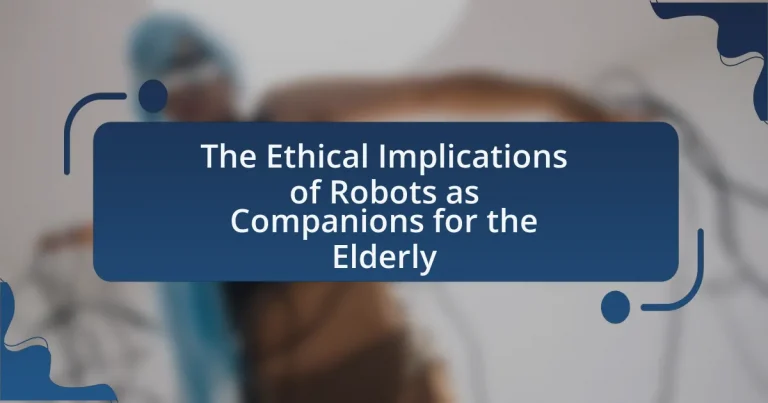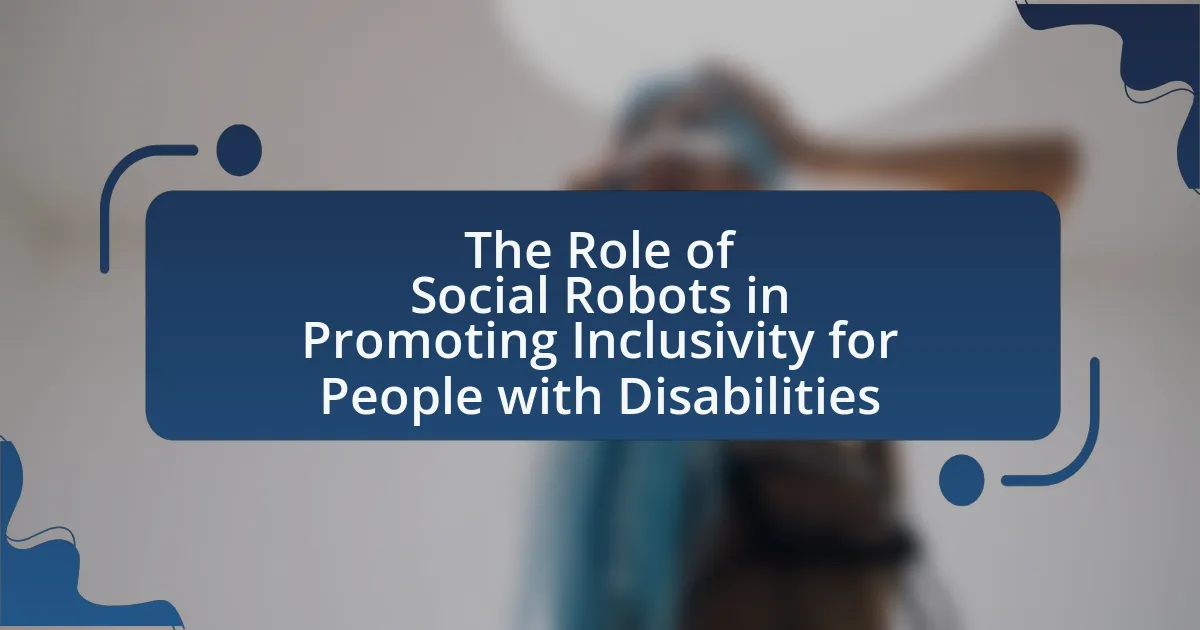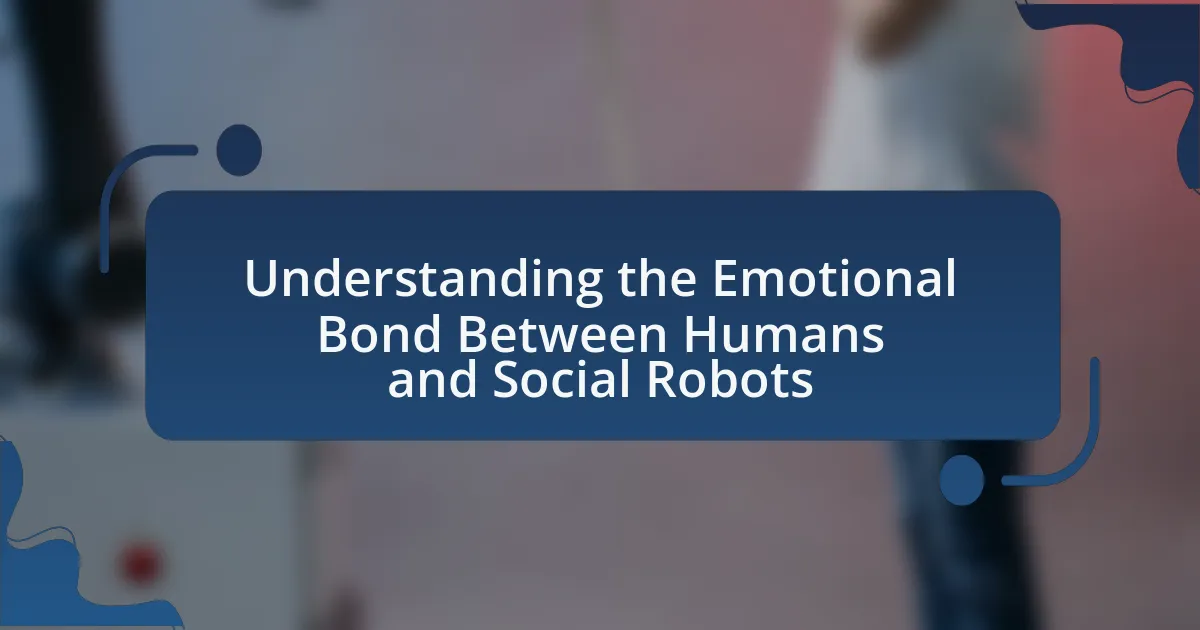The article examines the ethical implications of using robots as companions for the elderly, focusing on issues such as autonomy, privacy, and emotional attachment. It discusses how robots can provide social interaction, assist with daily tasks, and monitor health, thereby enhancing the quality of life for seniors. The article also highlights various types of companionship robots, their interactions with elderly users, and the ethical dilemmas that arise from their use. Additionally, it addresses cultural attitudes towards robotic companions, potential benefits, and concerns regarding emotional detachment and privacy issues, ultimately emphasizing the need for ethical considerations in the integration of robots into elderly care.
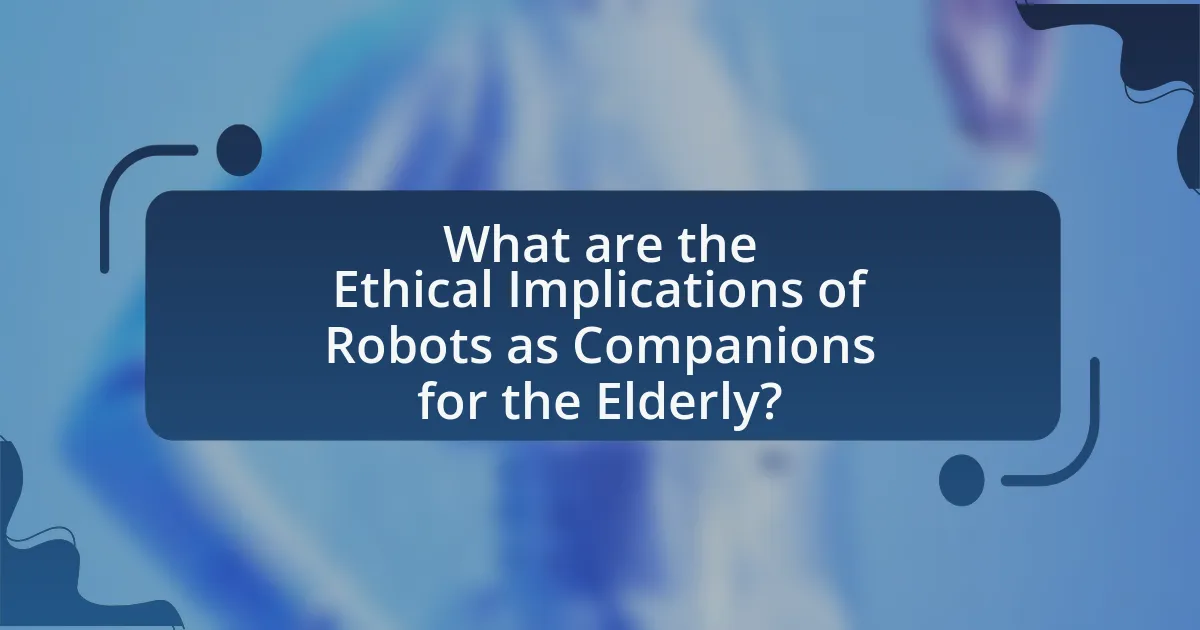
What are the Ethical Implications of Robots as Companions for the Elderly?
The ethical implications of robots as companions for the elderly include concerns about autonomy, privacy, and emotional attachment. These robots may inadvertently undermine the independence of elderly individuals by fostering reliance on technology for companionship and care. Additionally, the use of robots raises privacy issues, as they often collect personal data to function effectively, potentially leading to unauthorized access or misuse of sensitive information. Emotional attachment to robots can also pose ethical dilemmas, as it may affect the quality of human relationships and the emotional well-being of the elderly. Studies, such as those conducted by the University of Southern California, highlight these concerns, indicating that while robots can provide companionship, they may also complicate social dynamics and ethical considerations surrounding care for the elderly.
How do robots serve as companions for the elderly?
Robots serve as companions for the elderly by providing social interaction, assistance with daily tasks, and monitoring health. These robots can engage in conversations, play games, and offer reminders for medication, which helps reduce feelings of loneliness and isolation among seniors. Research indicates that companionship robots, such as Paro the therapeutic seal, have been shown to improve mood and reduce stress in elderly users, demonstrating their effectiveness in enhancing emotional well-being. Additionally, robots equipped with sensors can monitor vital signs and alert caregivers in case of emergencies, thereby ensuring safety and promoting independence for elderly individuals.
What types of robots are designed for elderly companionship?
Types of robots designed for elderly companionship include social robots, telepresence robots, and assistive robots. Social robots, such as Paro and ElliQ, engage in conversation and provide emotional support, enhancing social interaction. Telepresence robots, like Double and Beam, allow family members to connect with elderly individuals remotely, promoting social presence. Assistive robots, such as robotic pets and mobility aids, help with daily tasks and provide companionship, improving the quality of life for seniors. These robots are developed to address loneliness and support the emotional and physical needs of the elderly population.
How do these robots interact with elderly users?
Robots interact with elderly users primarily through communication, assistance, and companionship. These interactions often involve voice recognition, touch screens, and programmed responses that cater to the specific needs of elderly individuals, such as reminders for medication or social engagement. For instance, studies have shown that robots like PARO, a therapeutic robot seal, can elicit emotional responses and reduce feelings of loneliness among seniors, demonstrating their effectiveness in providing companionship. Additionally, robots equipped with sensors can monitor health metrics and alert caregivers in case of emergencies, thereby enhancing safety and well-being for elderly users.
Why is the ethical consideration of robots important in elderly care?
The ethical consideration of robots in elderly care is crucial because it directly impacts the dignity, autonomy, and well-being of elderly individuals. Ethical frameworks guide the design and deployment of robotic systems to ensure they respect the rights and preferences of older adults, preventing potential harm or exploitation. For instance, studies have shown that ethical guidelines can enhance trust in robotic companions, leading to improved mental health outcomes for seniors, as evidenced by research published in the Journal of Gerontology, which highlights the importance of ethical interactions in fostering positive relationships between robots and elderly users.
What ethical dilemmas arise from using robots as companions?
Using robots as companions raises several ethical dilemmas, primarily concerning autonomy, emotional attachment, and privacy. The autonomy dilemma arises when robots potentially replace human interaction, leading to questions about the elderly’s ability to make independent choices. Emotional attachment issues emerge as individuals may form bonds with robots, which can create dependency and affect mental health. Privacy concerns are significant, as robots often collect personal data to function effectively, raising questions about data security and consent. These dilemmas highlight the need for careful consideration of the implications of integrating robots into the lives of the elderly.
How do cultural attitudes influence the acceptance of robotic companions?
Cultural attitudes significantly influence the acceptance of robotic companions by shaping perceptions of technology, companionship, and caregiving. For instance, in cultures that prioritize familial bonds and human interaction, such as many Asian societies, there may be resistance to robotic companions, as they are viewed as inadequate substitutes for human relationships. Conversely, in Western cultures that emphasize individualism and technological advancement, acceptance tends to be higher, as robotic companions are seen as innovative solutions to loneliness and caregiving challenges. Research indicates that societal norms and values directly affect how different demographics perceive the role of robots in providing companionship, with studies showing that older adults in more technologically accepting cultures are more likely to embrace robotic companions for emotional support and assistance.
What are the potential benefits of using robots as companions for the elderly?
Using robots as companions for the elderly can significantly enhance their quality of life by providing emotional support, reducing feelings of loneliness, and assisting with daily tasks. Research indicates that social robots can engage in conversations, offer reminders for medication, and facilitate social interactions, which can lead to improved mental health outcomes. A study published in the journal “Gerontology” found that elderly individuals who interacted with companion robots reported lower levels of depression and anxiety, demonstrating the positive impact of robotic companionship on emotional well-being.
How can robots improve the quality of life for elderly individuals?
Robots can improve the quality of life for elderly individuals by providing companionship, assistance with daily tasks, and enhancing safety. For instance, social robots like Paro have been shown to reduce feelings of loneliness and depression among seniors, as evidenced by a study published in the Journal of Gerontology, which found that interaction with robotic pets significantly improved emotional well-being. Additionally, robots equipped with monitoring systems can assist in medication management and alert caregivers in case of emergencies, thereby increasing the safety and independence of elderly individuals. Research from the University of Southern California highlights that robotic assistance in daily activities can lead to a greater sense of autonomy and improved mental health outcomes for older adults.
What role do robots play in reducing loneliness among the elderly?
Robots play a significant role in reducing loneliness among the elderly by providing companionship and social interaction. Studies have shown that robotic companions, such as social robots and pet-like robots, can engage elderly individuals in conversation, offer emotional support, and encourage physical activity, thereby enhancing their overall well-being. For instance, research published in the journal “Gerontology” indicates that interactions with robots can lead to improved mood and reduced feelings of isolation among seniors. These robots can also facilitate communication with family members, further bridging the gap of loneliness.
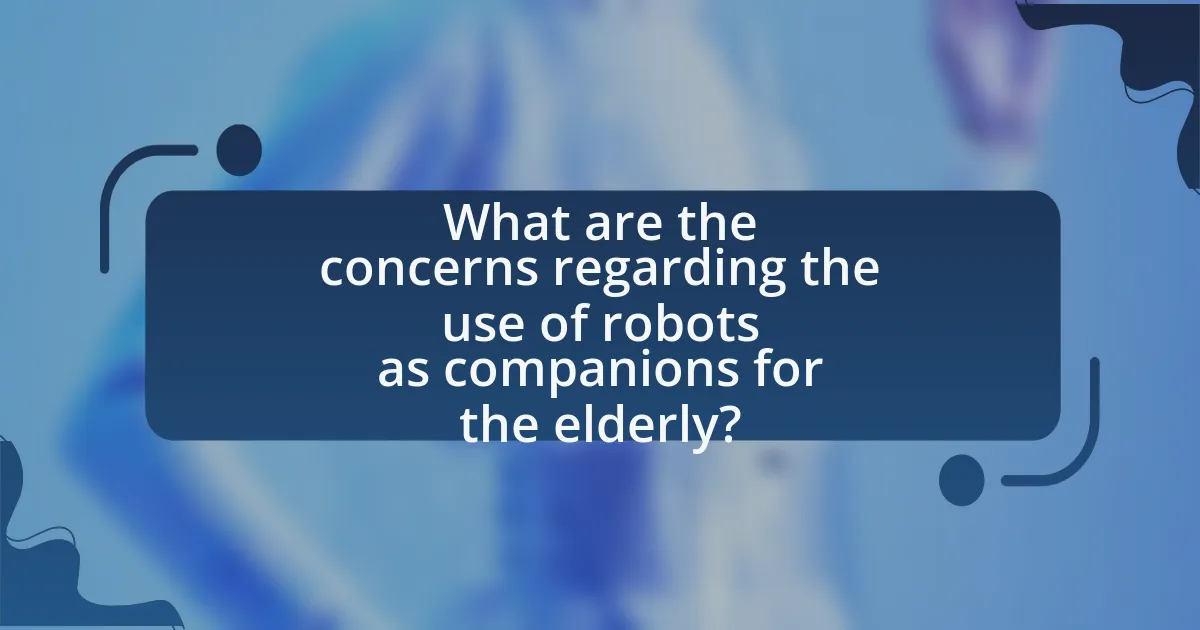
What are the concerns regarding the use of robots as companions for the elderly?
Concerns regarding the use of robots as companions for the elderly include potential emotional detachment, loss of human interaction, and ethical implications surrounding autonomy and privacy. Emotional detachment may arise as elderly individuals could become overly reliant on robots, leading to diminished social skills and isolation from human relationships. Research indicates that human interaction is crucial for mental health, and substituting it with robotic companionship may exacerbate feelings of loneliness. Additionally, ethical concerns involve the autonomy of elderly individuals, as robots may inadvertently manipulate decisions or behaviors, raising questions about consent and agency. Privacy issues also emerge, as robots often collect personal data, which could be misused or inadequately protected. These factors highlight the complexities and potential drawbacks of integrating robotic companions into the lives of the elderly.
What ethical concerns are raised about autonomy and privacy?
Ethical concerns regarding autonomy and privacy in the context of robots as companions for the elderly include the potential for diminished personal agency and the risk of unauthorized data collection. The introduction of robotic companions may lead to situations where elderly individuals feel their choices are influenced or controlled by technology, undermining their autonomy. Additionally, these robots often collect sensitive personal information to function effectively, raising concerns about how this data is stored, used, and shared. For instance, a study by the University of Cambridge highlights that elderly users may not fully understand the privacy implications of data collection by robotic systems, which can lead to unintentional breaches of privacy.
How do robots impact the autonomy of elderly users?
Robots enhance the autonomy of elderly users by providing assistance with daily tasks, thereby enabling them to maintain independence. For instance, robotic systems can assist with medication management, mobility, and communication, which reduces the need for constant human supervision. Research conducted by the University of Southern California found that elderly individuals using robotic companions reported increased feelings of independence and improved quality of life. This evidence supports the notion that robots can positively influence the autonomy of elderly users by facilitating their ability to live independently while ensuring their safety and well-being.
What privacy issues are associated with robotic companionship?
Robotic companionship raises significant privacy issues primarily due to the collection and processing of personal data. These robots often utilize sensors and cameras to interact with users, which can lead to the inadvertent capture of sensitive information, such as conversations and daily routines. A study by the University of Cambridge highlights that 60% of users are concerned about their data being misused or accessed by unauthorized parties. Additionally, the potential for hacking poses a risk, as malicious actors could exploit vulnerabilities in robotic systems to gain access to personal information. Thus, the integration of robotic companions necessitates stringent data protection measures to safeguard user privacy.
How do robots affect the social dynamics of elderly care?
Robots significantly influence the social dynamics of elderly care by providing companionship and assistance, which can reduce feelings of loneliness and isolation among seniors. Research indicates that the presence of robots, such as social robots designed for interaction, can enhance emotional well-being and foster social engagement, as evidenced by studies showing that elderly individuals interacting with robots report higher levels of happiness and lower levels of depression. For instance, a study published in the journal “Gerontechnology” found that seniors who engaged with robotic companions experienced improved social interactions and a greater sense of connection to their community. This shift in social dynamics can lead to a more supportive environment for elderly individuals, ultimately enhancing their quality of life.
What is the impact of robotic companions on human relationships?
Robotic companions significantly impact human relationships by providing emotional support and companionship, particularly for the elderly. Studies indicate that these robots can reduce feelings of loneliness and depression, enhancing the overall well-being of users. For instance, research published in the journal “Gerontechnology” demonstrates that elderly individuals interacting with robotic companions reported increased social engagement and improved mood. Additionally, robotic companions can facilitate communication and connection with family members, bridging gaps in social interaction. This dual role of providing direct companionship while also enhancing human connections underscores the transformative potential of robotic companions in the context of aging populations.
How do caregivers perceive the use of robots in their work?
Caregivers generally perceive the use of robots in their work as a beneficial tool that can enhance patient care and alleviate some of their workload. Many caregivers recognize that robots can assist with routine tasks, such as medication reminders and monitoring vital signs, which allows them to focus more on personal interactions with patients. Research conducted by the University of California, Berkeley, found that 70% of caregivers reported feeling more efficient and less stressed when using robotic assistance in their daily routines. This indicates a positive perception of robots as supportive companions rather than replacements, highlighting their potential to improve the quality of care provided to the elderly.
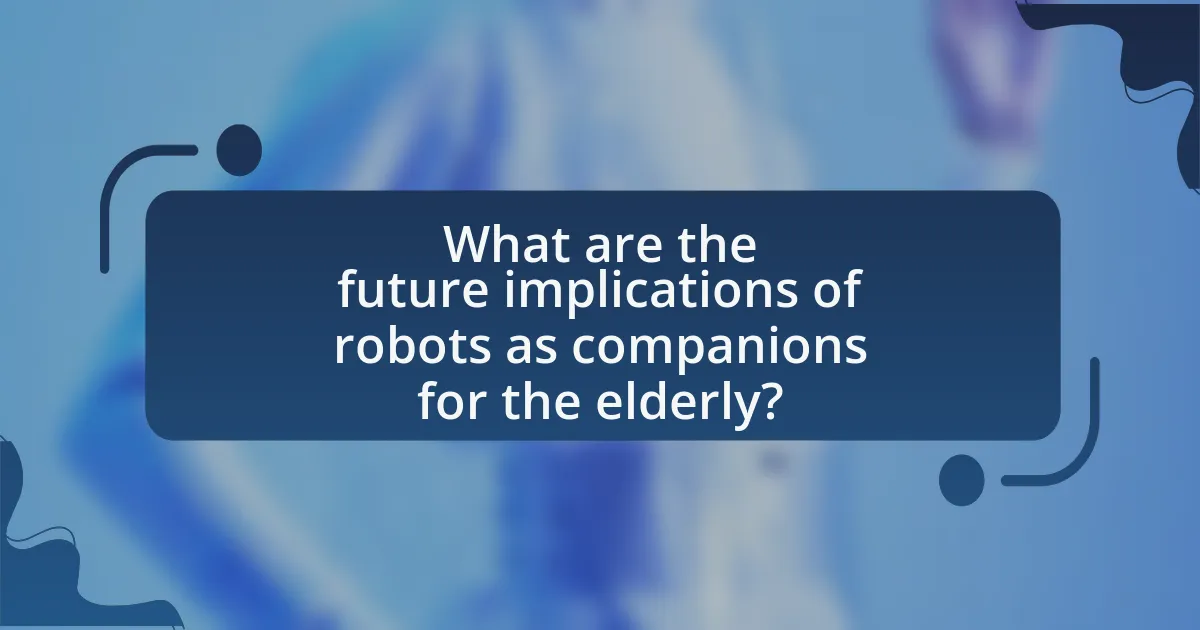
What are the future implications of robots as companions for the elderly?
The future implications of robots as companions for the elderly include enhanced social interaction, improved mental health, and increased independence. Research indicates that social robots can reduce feelings of loneliness and depression among older adults, as evidenced by a study published in the journal “Gerontology” which found that elderly individuals interacting with robots reported higher levels of emotional well-being. Additionally, robots can assist with daily tasks, promoting autonomy and allowing seniors to live independently longer, which is crucial given that the global population aged 65 and older is projected to reach 1.5 billion by 2050, according to the United Nations. These advancements suggest that robots will play a significant role in addressing the challenges of an aging population, ultimately improving the quality of life for elderly individuals.
How might technology evolve to enhance robotic companionship?
Technology might evolve to enhance robotic companionship through advancements in artificial intelligence, emotional recognition, and adaptive learning. These developments will enable robots to better understand and respond to human emotions, fostering deeper connections. For instance, AI algorithms can analyze facial expressions and vocal tones to gauge emotional states, allowing robots to provide tailored support and companionship. Research indicates that robots equipped with such capabilities can significantly improve the quality of life for elderly individuals by reducing feelings of loneliness and isolation. A study published in the journal “Gerontechnology” found that elderly participants reported increased satisfaction and emotional well-being when interacting with emotionally intelligent robots.
What advancements in AI could improve robot interactions with the elderly?
Advancements in AI that could improve robot interactions with the elderly include enhanced natural language processing, emotional recognition, and adaptive learning algorithms. Enhanced natural language processing allows robots to understand and respond to complex human speech, making conversations more fluid and engaging. Emotional recognition technology enables robots to detect and respond to the emotional states of elderly users, fostering a sense of companionship and support. Adaptive learning algorithms allow robots to personalize interactions based on individual preferences and behaviors, improving user satisfaction and engagement. These advancements are supported by studies showing that effective communication and emotional connection significantly enhance the quality of care and companionship provided by robotic systems to the elderly.
How can future robots be designed to address current ethical concerns?
Future robots can be designed to address current ethical concerns by incorporating transparency, accountability, and user-centered design principles. Transparency ensures that users understand how robots make decisions, which can alleviate fears about autonomy and control. For instance, implementing explainable AI allows users to see the reasoning behind a robot’s actions, fostering trust.
Accountability can be established through clear guidelines on the responsibilities of developers and manufacturers, ensuring that ethical standards are met throughout the design and deployment process. Research by the IEEE Global Initiative on Ethics of Autonomous and Intelligent Systems emphasizes the importance of ethical frameworks in technology development, highlighting that accountability mechanisms can mitigate risks associated with robotic companions.
User-centered design involves actively engaging elderly users in the development process to ensure that their needs and preferences are prioritized. This approach can lead to robots that are not only functional but also respectful of the dignity and autonomy of elderly individuals. By integrating these principles, future robots can effectively address ethical concerns while enhancing the quality of life for elderly users.
What best practices should be considered when implementing robots as companions for the elderly?
When implementing robots as companions for the elderly, best practices include ensuring user-friendly interfaces, prioritizing safety, and fostering emotional connections. User-friendly interfaces are essential, as studies show that elderly individuals may struggle with complex technology; thus, intuitive designs enhance usability and acceptance. Safety must be prioritized, as robots should be equipped with features that prevent accidents, such as obstacle detection and emergency response capabilities, which are critical for maintaining the well-being of elderly users. Additionally, fostering emotional connections through personalized interactions can significantly improve the quality of companionship, as research indicates that emotional engagement can reduce feelings of loneliness and depression among seniors.
How can caregivers ensure ethical use of robots in elderly care?
Caregivers can ensure the ethical use of robots in elderly care by adhering to established ethical guidelines and prioritizing the dignity and autonomy of elderly individuals. This involves conducting thorough assessments of the needs and preferences of the elderly, ensuring that robots are designed and programmed to respect these individual choices. Additionally, caregivers should engage in ongoing training about the ethical implications of robotic assistance, emphasizing transparency in communication with elderly users and their families regarding the capabilities and limitations of the robots. Research indicates that ethical frameworks, such as the principles outlined by the IEEE Global Initiative on Ethics of Autonomous and Intelligent Systems, provide a foundation for responsible robot deployment in care settings, ensuring that the technology enhances rather than undermines the quality of life for elderly individuals.
What guidelines should be followed to maximize the benefits of robotic companions?
To maximize the benefits of robotic companions, it is essential to ensure they are designed with user-friendly interfaces and tailored functionalities that meet the specific needs of elderly users. Research indicates that when robotic companions are intuitive and customizable, they enhance user engagement and satisfaction, leading to improved mental well-being and reduced feelings of loneliness among the elderly. For instance, a study published in the journal “Gerontechnology” found that elderly individuals using user-friendly robotic companions reported a 30% increase in social interaction and a 25% decrease in depressive symptoms. Additionally, regular updates and maintenance of the robotic systems are crucial to ensure reliability and effectiveness, as malfunctioning devices can lead to frustration and decreased trust in technology.
